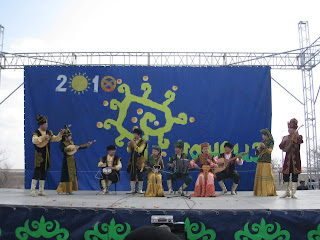Icons, sculptures, models, paintings are present everywhere in Baikonur.
The purpose they deserve is two fold:
- to keep the memory of all what contributed to write space history since 1955
- and not to forget that Baikonur lays is in Kazakhstan, a country with secular traditions and culture.
Art is so well integrated in the street landscape that the visitor does feel to be in an "open air museum", except may be for those who live here the whole year...

Looking closer, one will be amazed by the wide range of art styles and techniques which cohabit in the city:
A.A Maximov 1923-1990, on A.A. Maximov street (fragment)

- The Stele of Science and Cosmos or the statue of Lenin on his pedestal are good examples of former Soviet "official art" : A mixture of figurative and allegoric representations, always large and massive, carrying a socio-political message.
Lenin statue on Lenin square
- A last category of works is more difficult to define because it may appear more simple, less homogeneous, and using less sophisticated/costly techniques. This "spontaneous art", even if this denomination is not fully satisfactory, strikes anyway by its originality and power of expression: A mixture between church icons and comic strips... How to make that a simple rocket, a spacecraft or an astronaut in his spacesuit become suddenly a piece art? This, in fact, has been made possible in Baikonur by the talent of anonymous (?) artists. Their remarkable works, as it will be seen here after, are spread all over the city...
The first striking master piece may be the huge mosaic that welcomes visitors entering the city coming from the commercial airport: A flying astronaut, stares at you, with stretched arm in horizontal position like aircraft wings. This monument was erected for the 50th anniversary of Baikonur.
(fragment)
Credits: Andrei
Mosaic technique is also used on the Abai wall (Abai Monument on the Abai Prospekt) in the city. Here under are represented traditional scenes of the Kazakh daily life: Mother and child, Kobuz player, agriculture...
(fragment)
A last example on the west facade of the "Pioneers"Palace next to the St george church.
(fragment)
Another technique is the painting over the wall or concrete. The space "ballet" of these 2 supple cosmonauts around the planet is superbly drawn rendering remarkably the feeling of weightlessness.
(
on Titov street)

Large painted panels cover some facades on the Arbat, the pedestrian shopping street of Baikonur. Here under a cartoon-like space odyssey between stars and comets...

This other remarkable painting below on the Korolev Prospekt could deserve a special note on its own. Numerous items, mixing rounded and orthogonal lines, are this time fully integrated in a single composition: the fusion of Kazakh culture with modern technology? The yellow and blue colours look like a photographic negative: Alternation of days and nights or natural balance between life on Earth and the Cosmos? ...A new harmonious world is under construction.

Carved wall or plaster is also a technique used at several places in the city. The quality of the workmanship may vary from place to place. The one below is likely not the most refined, but who cares.... This interesting work may have been carried out by some workers of the RPB factory (located just behind the energy plant) at the time of the Soviet Union (?). Here again, the carved material use a language close to the "squares" of a comic strip. This patchwork represents all technological achievements made by this company. A way also for the artists to express their pride and to contribute to the fame of the (CCCP) regime at the time.

The same technique is used here with a better workmanship. This "wall" officially commemorates the renaming of the city of Baikonur in 1995. It addresses this time the soviet lunar programme (
Lunokhod), Buran and the space exploration.
(fragment)
Coming back to the Abai monument, this carved or molded wall very nicely captures the main features of the Kazakh daily life (as the mosaic mentioned above).

A close up
-on the traditional
Golden Eagle (
Беркут) hunting,

-or here on the camel caravans crossing Kazakhstan. The old "
silk road" was far more in the south of the country, but a northern bifurcation heading to Moscow and Finland, may have passed along the Syr Daria not very far from Baikonur...

These examples picked up at random are certainly not exhaustive of the ART found in the Baikonur streets but just show how extraordinary rich is the patrimony of the space city.
Most of these remarkable works are not signed, and likely carried out by anonymous artists. The omnipresence of this "popular art'' makes walking in Baikonur extremely pleasant.
This Art is fragile and certainly suffers from the cold conditions of the place. Some pieces are becoming old and start to need a serious "lifting". It would be a piety that such a priceless memory would vanish.












































